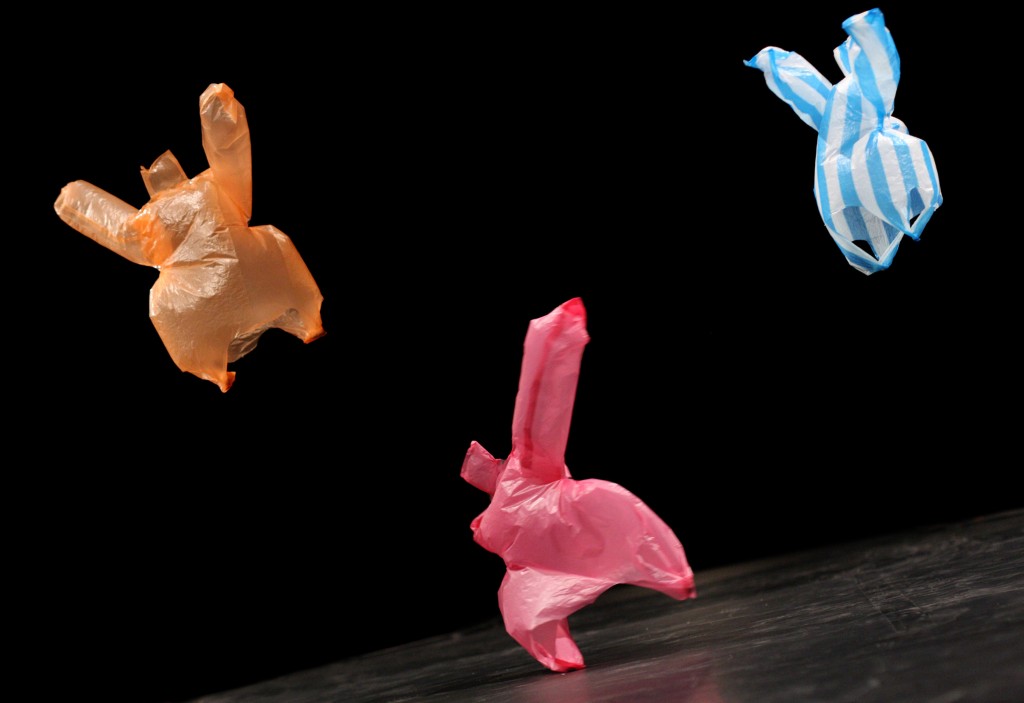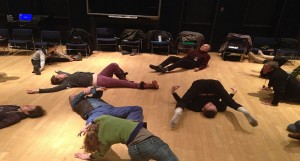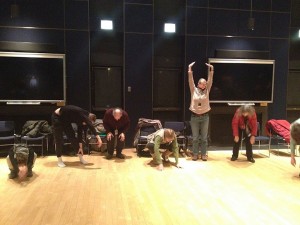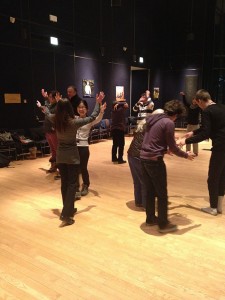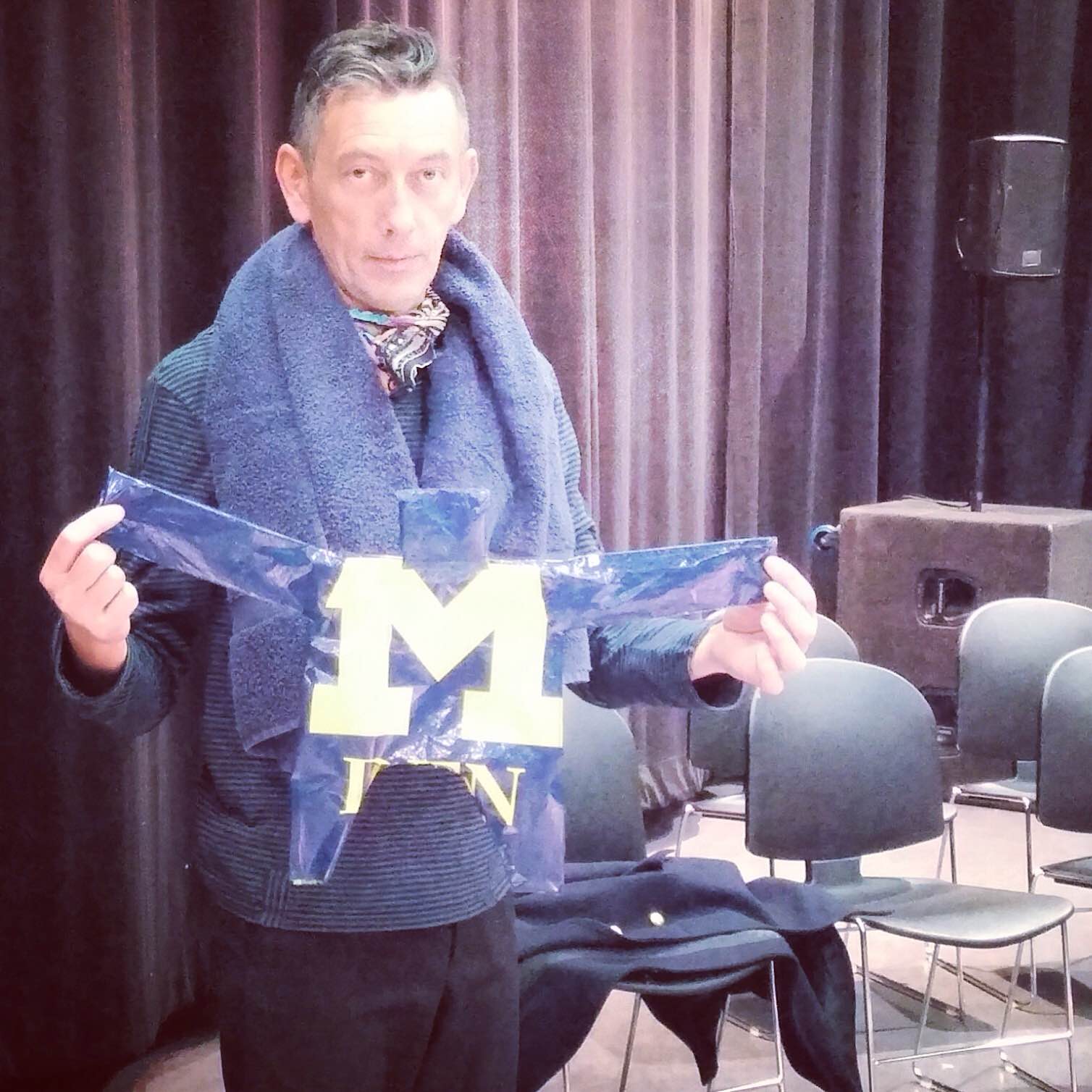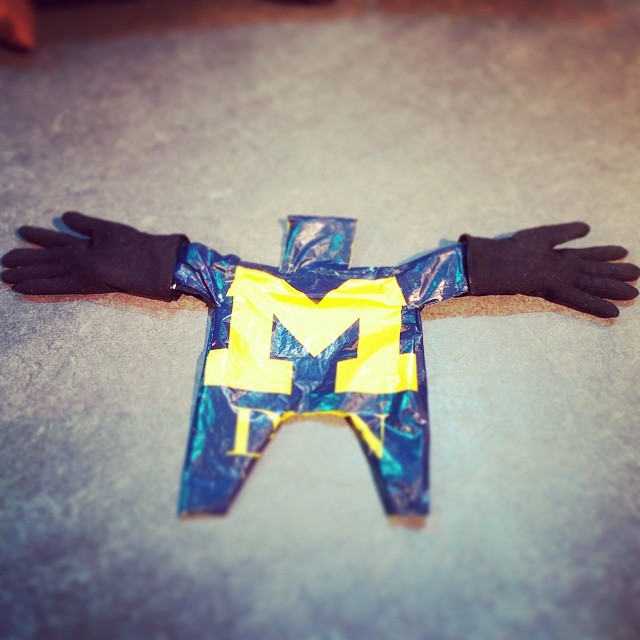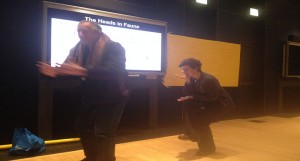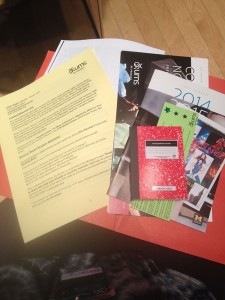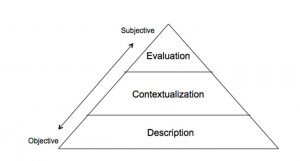Resident Update: Artist Carolyn Reed Barritt on Compagnie Non Nova
Painter Carolyn Reed Barritt is a UMS Artist in Residence this season. We’ve asked five artists from across disciplines to take “residence” at our performances and to share the work these performances inspire.
Carolyn attended Compagnie Non Nova‘s performance of Afternoon of a Foehn this past weekend at Skyline High School’s black box theatre. She shares her thoughts on the performance:
“I didn’t think I could be so enraptured by ordinary plastic bags…The performance is mastered chaos — each fan controlled to create an airflow which allows the bag puppets to twirl, float and wrestle with each other and their creator in a confined space. Sometimes the puppets skate together along the floor; sometimes it seems as though they are tying to escape by floating up to the ceiling. Sometimes they seem to attack each other. Their creator moves with them, allowing them to dance and fight until they turn on him, using the wind that animates them to envelope and smother him with their bodies, making him so angry he destroys them all. The audio track ebbs and flows from sublime to sinister, the bag puppets go from charming to vindictive, the single, silent actor, ghost-like and imperious — all this in a home-made wind vortex.
If you’re lucky enough to be in Ann Arbor Michigan right now, there are more shows this coming weekend (February 19 – 21, 2015). Otherwise I hope this show comes to you someday!”
Read the full post on Carolyn’s blog
Interested in learning more? Read our interview with Carolyn.
UMS Night School: Curious About Dance – Session 2 Recap
Editor’s note: This post is a part of a series of by U-M student and UMS intern Hillary Kooistra, who’s covering our free UMS Night School: Curious About Dance workshop series.
It’s Just So…French
We might be facing sub-zero temperatures outside this week, but things were definitely heating up in the U-M Alumni Center on Monday night. We began our second Night School session with a stimulating conversation about Compagnie Non Nova’s Afternoon of a Foehn, then launched into a movement workshop led by newly Chicago-based solo contemporary artist Anna Martine Whitehead. Gestures played a key role in Monday’s session; in both our post-show reflection and Martine’s movement workshop, we found ways to make meaning through the creation, manipulation, and reimagination of repeated motions.
To begin the session, Clare reintroduced our Night School ritual: saying our names while performing a gesture. This time, as a way to kick off the conversation about Compagnie Non Nova, we recalled and produced gestures from the performance. Afternoon of a Foehn runs through next weekend, so those of us who have not yet seen it were instructed to amplify someone else’s gesture. The result? A highly creative game of movement telephone that had us moving in, out, and through our circle in response to one another’s memories of the performance.
We then shared the significance of the gestures we picked, and identified themes and concepts that stuck with us as we watched the performance. What makes a strong visual in performance? How do the rules established in performance alter our expectations of what is to come? How can the performance space change throughout the narrative, and how can it change us? These are only some of the questions that came up as we dissected our own interpretations of the captivating piece of experimental theatre (/dance/ballet/performance art…as we discussed, the category in which it falls is really up to interpretation).
We also landed on a discussion about the conventions of French performance, and how American audiences identify the work produced by European companies as well…European. The hierarchies of performers, sense of pride in claiming a space, and abstraction of narrative are some of the aspects we landed on as, to quote Clare, “just so…French.” For those who plan to head to Skyline High School this weekend, I’d be curious to hear if these concepts stick out to you as you watch the performance.
Warming up for a movement workshop by exploring negative space and interacting with others.
Our discussion of the many ways to approach and interpret Afternoon of a Foehn served as a perfect segway to Martine’s workshop, which centered around the choreographic approach of rethinking movement. She associated this process with Queer Dance, which offers alternative ways to think about gender and sexuality, critique the normal, and imagine other ways to be in the world. Martine will demonstrate this mode of thinking in this week’s performance of Confetti Sunrise, which features the work of Martine and four other queer artists. The workshop served to prepare us for this show, as well as for this weekend’s performance by the Trisha Brown Dance Company.
Throughout the half hour we spent stretching, speaking, moving, and listening, Martine invited us to think: How can gesture make meaning? How can we embellish it, and do it so much that it creates own score? She invited us to act on our instinct, focusing on the concepts of compulsion and desire.
Indulging in stretches during Anna Martine Whitehead’s movement session!
We ended the session in conversation with a partner, during which words were not the primary conversational agents. Responding to the prompt “tell me something that nobody knows,” we performed for our partners a series of gestures that they recalled and repeated back to us. We then manipulated the gestures that we grabbed from our partners (embellished, amplified, repeated, took to a different level…) and created a repeatable sequence–known in dance as a phrase. The exercise encouraged us to think about movement, maybe first as a substitute for words, but then as its own entity whose meaning might veer away from the choreographer’s original narrative.
My fantastic partner, Howard, tells me something that nobody knows using only gestures.
Howard recalls the gestures I conveyed to tell him something that nobody knows.
I was happy to think about this exercise not only from a Queer Dance perspective, but within the context of Trisha Brown. I interned for the company this past summer through UMS’s 21st Century Artist Internship Program, and I was lucky enough to take composition/improvisation classes with Associate Artistic Director Diane Madden while I was there. In class, Diane introduced to me Trisha’s choreographic method of “throwing and catching” movement: Trisha often performed gestures or longer series of movement for her dancers, then asked them to repeat them back to her without ruminating on what they saw. The dancers’ interpretations of her movements ultimately inspired much of her choreography. As I explored this process over the summer, I developed an awareness of how I interpreted movement and how my own movement resonated with others. I was excited to return to this way of working in Night School, and to draw ties between Trisha’s historic work and the innovative contemporary work of Queer Dance artists.
Silent conversations with partners–using gestures to convey meaning.
Speaking of Trisha Brown, we have quite the marathon of dance ahead of us in Ann Arbor this week! Compagnie Non Nova, Confetti Sunrise, Trisha Brown, Dance on Camera…we can have a quadruple bill if we really want to! Remember, if you go to more than one performance this weekend, you are eligible for double stars on your UMS Card. More stars, more dance, more fun.
Next Monday, we will be joined by U-M Associate Professor of Dance Amy Chavasse for our discussion of Confetti Sunrise and Trisha Brown. Then we get to raise a cupcake to Clare in celebration of her new book! She and Jim will be in conversation about Dancers as Diplomats: American Choreography in Cultural Exchange for the latter half of our session, so come hungry for treats and lots of dance talk! (Photocopies of Clare’s first two chapters can be found in our Night School folders, if anyone wants to complete a little pre-reading.)
Events This Weekend:
- Compagnie Non Nova, Afternoon of a Foehn, Feb. 14-21, various times, Skyline High School. TICKET REQUIRED
- Confetti Sunrise, Feb. 18-19, 7:30pm, U-M Duderstadt Center, Video Studio (FREE BUT LIMITED SEATING, FIRST COME FIRST SERVE)
- Dance on Camera Festival, Feb. 21-22, 6pm, U-M Museum of Art, FREE
- Trisha Brown Dance Company Performances, Feb. 21-22, 8pm, Power Center. TICKET REQUIRED
- Related Events:
- Feb. 21: You Can Dance: Trisha Brown Dance Company, Ann Arbor YMCA, 10:45am-12:15pm (SIGN-UP REQUIRED, BEGINS AT 10AM, FIRST COME FIRST SERVE)
- Feb. 21: Tune In: Trisha Brown Dance Company, Power Center Lobby, 7:30-7:45pm (TICKET REQUIRED)
- Feb 21: Opening Night Q&A: Trisha Brown Dance Company, Power Center, post-performance (TICKET REQUIRED)
- Related Events:
Session 2 Resources and Readings:
Dancers as Diplomats by Clare Croft
Introduction
Chapter 2
Compagnie Non Nova creates an M-Den dancer!
Come see Compagnie Non Nova: Afternoon of a Foehn this week: http://bit.ly/1pMpL5z M-Den Bag might even make an appearance!
UMS Night School: Curious About Dance – Session 1 Recap
Editor’s note: This post is a part of a series by U-M student and UMS intern Hillary Kooistra, who’s covering our free UMS Night School: Curious About Dance workshop series.
Not New, But In a New Way
If one thing was made clear from Monday’s first session of Night School (besides the fact that Clare Croft calls “intermission” “half time” like in basketball games), it’s that there are tons of awesome dance performances happening in Ann Arbor this winter. Between intimate experimental works, large-scale productions, films screenings, and more, we’ll have plenty to discuss in our Night School sessions each week. As a senior Dance Major at U-M and an avid fan of performances that push the boundaries of how we interpret movement and storytelling, I am definitely looking forward to unfolding this Night School series with a new cohort of dance enthusiasts. I’ve only experienced an hour and a half of Night School so far, but I can tell I’m going to have a great time, especially knowing that each session will be led by two wonderful members of the U-M Department of Dance: Professor Clare Croft and first-year MFA candidate Charles Gushue.
Curious about dance, and all ready for Night School!
We began tonight’s session with a crash course in watching and writing about dance. Clare, a longtime dance critic and writer (who just celebrated the publication of her new book!) showed us some examples of writing that successfully paints a picture of movement on stage. We then engaged in our own writing exercise: we watched four fellow classmates embody aliens exploring the planet and came up with our own descriptive sentences based on the detailed notes we took during their performance.
We observed these four Night School participants and came up with sentences to describe their movement and interactions with the space. It definitely wasn’t too difficult to come up with colorful metaphors, given these vivid characters and images!
Writing about dance begins with observation, and requires awareness and acknowledgement of what it is that we notice. As we observed these “tasty little animals moving through the jungle” (as described by one Night School student), Clare prompted us to take note of details such as how the performers interacted with objects in the space, how they directed their focus, which body parts they maneuvered.
The three major elements of successful dance writing.
After we landed on some descriptions that envied the writing of Deborah Jowitt, Charles launched into a set of activities that prepared us for this weekend’s performance: Afternoon of a Foehn, presented by Compagnie Non Nova. This experimental work is set to Claude Debussy’s Prelude to the Afternoon of a Faun, which also serves as the musical score for the Vaslav Nijinsky ballet L’après-midi d’un faune (The Afternoon of a Faun). Charles shared his experiences dancing Nijinsky’s Faun, and introduced labanotation as a way of seeing how the ballet choreographer recorded his movement on paper.
Night School students Harvey and Linda try out one another’s movement via labanotation.
We experimented (and jovially struggled!) with our own versions of labanotation, then got a taste of Compagnie Non Nova’s interpretation of the Debussy score through plastic bags, which serve as the main playing characters for the production. As we tossed these bags around the circle like a group of slap happy children on the playground, Charles invited us to call out words that described our actions–returning to Clare’s earlier point about how we can use words to describe the movement and interactions we notice. This is what I love about the versatility of the Night School series: in one session, we can regard the movement of the Trisha Brown Dance Company and flitting plastic bags as equally legitimate agents for describing and discussing dance.
Having fun exploring the motions of plastic bags in preparation for Compagnie Non Nova!
Next week, we’ll kick things off with a reflection of Compagnie Non Nova, then begin to prepare for the next set of performances. We will be joined by U-M Associate Professor of Dance Amy Chavasse, who will introduce us to work of the Trisha Brown Dance Company (performances at Power Center Saturday, 2/21 and Sunday, 2/22); and solo contemporary artist and performer Anna Martine Whitehead, who will appear in the U-M Department of Dance performance of Confetti Sunrise (Wednesday, 2/18 and Thursday, 2/19 at the U-M Duderstadt Center Video Studio). These productions, Afternoon of a Foehn included, will each offer us new ideas about how to view and interpret performance, and I can’t wait to see what discussions surface in next week’s session!
Performances this weekend: Compagnie Non Nova, Afternoon of a Foehn, Feb. 14-21, various times, Skyline High School. TICKET REQUIRED.
Session 1 Resources and Readings:
Dancers as Diplomats by Clare Croft
Introduction
Chapter 2
Performing Objects: Beyond Puppetry
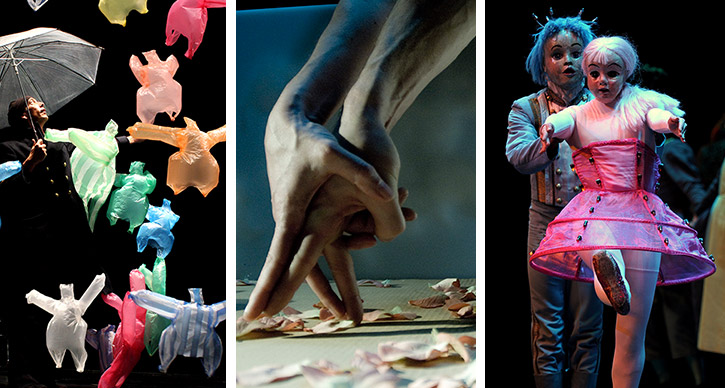
Examples of object performance abound in our 2014-2015 season. From left to right, Prelude to the Afternoon of a Foehn, Kiss & Cry, and Cinderella. Photos courtesy of the artists.
A plastic bag caught in the wind. Two hands intertwined in a miniature embrace. A doll-like mask covering a dancer’s face.
Each of these performing objects will make an appearance on a UMS stage this season.
But what exactly are “performing objects”? Are they puppets? Or something else?
In the 1980s, puppet scholar Frank Proschan defined “performing objects” as “material images of humans, animals or spirits that are created, displayed, or manipulated in narrative or dramatic performance.” By design, this is an exceedingly broad umbrella term; performing objects include but exceed traditional definitions of puppetry, which are themselves expanding. As scholar Claudia Orenstein describes it, “When we say ‘puppet’ we are no longer speaking exclusively of the figurative, crafted characters dangled from strings, gloved on hands, or attached to rods that the word had previously evoked: the Punch, Guignol, Howdy Doody, Lamb Chop, Kukla and Kermit characters of our childhoods.”
Performing objects multiply the physical, psychological and emotional possibilities of what can be done on stage. Objects have movement capacities that humans do not possess; though objects can be anthropomorphized and ascribed humanlike emotional qualities, they are often used to push the boundaries of what is acceptable or tasteful, in ways that would be more difficult for audiences to accept with a human performer.
Last season, UMS audiences saw three masterful performances of puppetry. The UK’s Blind Summit created both the series of life-size puppets representing the title character in Complicite’s Shun-kin and the pint-size Biblical imp Moses in The Table; though these puppets were very different in appearance and in the role they played in each production, all were created in the bunraku tradition from Japan, which utilizes three puppeteers to operate each puppet. Our audiences were also able to see the work of another modern puppet innovator, South Africa’s Handspring Puppet Company, in our National Theatre Live broadcast of War Horse. Their massive, startlingly beautiful and emotionally resonant horse puppets for that piece are critical to the impact of that World War I tale, which has played to great acclaim worldwide.
This season builds on those experiences and provides several rich examples of “performing objects” in Kiss & Cry, Prelude to the Afternoon of a Foehn, and Cinderella, where objects take on a degree of humanity, and human bodies and body parts are rendered as objects.
Behind the scenes with Kiss & Cry:
In Kiss & Cry hands, anatomized in close-up on projected film images, stand in for the whole person; the work’s dramatization of romantic entanglements takes on a level of revelatory strangeness while still maintaining the intimacy of genuine human contact. In Lyon Opera Ballet’s Cinderella, the traditional romance of the fairy tale and Prokofiev’s score are undercut and made humorous by the prominent use of toys on stage. Additionally, the dancers themselves are depicted as toys: faces covered in doll-like masks, they also move with the articulated stiffness of dolls.
A selection from the performance of Prelude to the Afternoon of a Foehn:
In Prelude to the Afternoon of a Foehn, everyday plastic shopping bags dance their own kind of ballet, manipulated by a single human performer and a series of electric fans. Tied to mimic the human form, reminiscent of balloon animals in a variety of bold colors, the bags beautifully illustrate Debussy’s score and complicate our notions of these objects as trash.
Performing objects mimic, illuminate, and make strange both the human form and human experience. Using a variety of materials, from the elevated to the everyday, the artists creating these works invite us to see the world in new and marvelous ways.
Have questions for Shannon? Ask them in the comments below.


